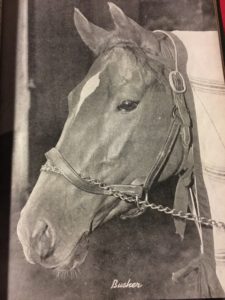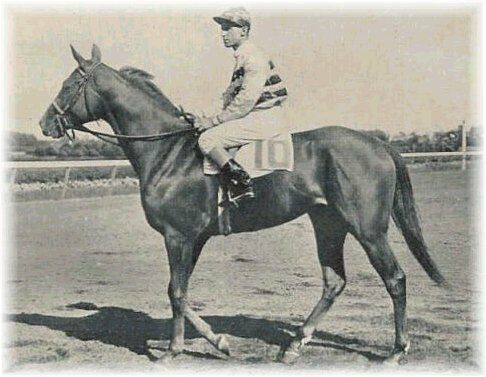
by TERESA GENARO
It should be clear by this time … that Busher has as good a chance to take the best three-year-old colts as Gallorette.
“The Deadly Demoiselles” by Tasker Ogle, Turf and Sport Digest, September 1945
 Before those words were written, the three-year-old Busher, bred by E.R. Bradley’s Idle Hour Farm, had already beaten not only the colts of her generation but also older males, too, in both the Washington Park and Arlington Handicaps. Her sophomore campaign, with a record of 13-10-2-1 and earnings of $273,735, was good enough to net her two champion titles in 1945: three-year-old filly and Horse of the Year. This followed in the footsteps of Twilight Tear, who’d accomplished the same the previous year.
Before those words were written, the three-year-old Busher, bred by E.R. Bradley’s Idle Hour Farm, had already beaten not only the colts of her generation but also older males, too, in both the Washington Park and Arlington Handicaps. Her sophomore campaign, with a record of 13-10-2-1 and earnings of $273,735, was good enough to net her two champion titles in 1945: three-year-old filly and Horse of the Year. This followed in the footsteps of Twilight Tear, who’d accomplished the same the previous year.
Busher never raced at Aqueduct, where on Saturday a race will be run in her honor. She began her career racing for her breeder at Belmont Park, but before she began her 1945 campaign, Bradley sold her to Hollywood’s Louis B. Mayer, reportedly for $50,000 (about $650,000 in today’s dollars), and she ran primarily at Santa Anita, Washington Park, and Hollywood.
Originally trained by J.W. Smith, the daughter of War Admiral won the Adirondack and the Matron en route to becoming the champion two-year-old filly with O’Neil Sevier noting in the December 1944 Turf and Sport Digest that her margin of winning votes was bigger than any other category that year; she received 410 votes; runner-up Price Level received 187.
After the move to the West Coast, Busher became a superstar in her time, beating colts in the 1945 San Vicente and finishing second by a half-length in the Santa Anita Derby, going off the 1-2 favorite; in the August 1945 Turf and Sport Digest, Sevier put the blame for that loss on jockey Johnny Longden, asserting that Longden’s affinity for racing wide had cost the filly the race.
Two weeks later, she won the Santa Margarita Handicap under 126 pounds before shipping East, beating males again—by four and a half lengths—in the Washington Handicap, setting a track record of 2:01.80 for 1 ¼ miles and defeating future Hall of Famer and next year’s Horse of the Year Armed. The photo caption in the Chicago Tribune read, “A Game Little Lady Breaks A Record.”
In August 1945, the chestnut filly raced three times—a Arlington Handicap win, a third-place finish in the Beverly Handicap, and a three-quarters of a length win in a match race against Durazna, the champion two-year-old filly of 1943, who, like Busher, not uncommonly raced against males, both her age and older.
A 1945 Time magazine article about Busher’s 1945 honors characterized the filly as a “lazy worker who never does anything more than is asked of her.” A slightly more complimentary article about her achievements appears in the December 1945 New York Times.
She was inducted into the Hall of Fame in 1964, and 14 years later, the New York Racing Association elected to honor her with a race in her name.
“Certainly Busher must be accorded a place among the great fillies of racing history,” wrote Robert F. Kelley in Racing in America: 1937-1959, “on the strength of her Three-year-old season, if for no other. Here she not only more than held her own with members of her own sex, but she went out and defeated good colts and the remarkable gelding, Armed.”





The race that Busher won beating Armed was not the ArlingtonPark Handicap. The race was the Washington Park Hdcp.Run on Labor Day 1945.
Nice article. And thanks so much for the links to the sources!